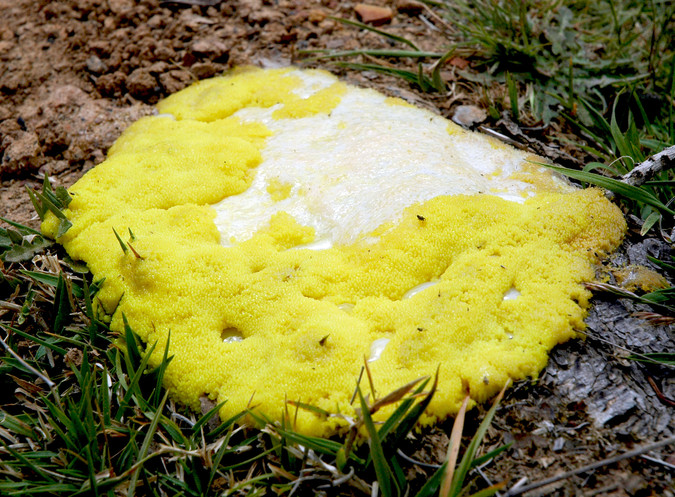The Wrack
The Wrack is the Wells Reserve blog, our collective logbook on the web.
The Wrack is the Wells Reserve blog, our collective logbook on the web.

The following was published in the Biddeford-Saco Journal Tribune Sunday edition, 7/19/2015.
The Fuligo septica, or dog vomit slime mold, as it is picturesquely known, appeared in our front garden after a particularly humid day last week. The five-inch-wide, bright yellow splatter was impossible to miss on the black mulch. To the touch, it felt like scrambled eggs. My son declared it “ick.” I was delighted.
I am a fan of slime molds. (Also of slimy molds, like the Gymnosporangium juniperi-virginianae that appeared in the juniper bushes in the Wells Reserve at Laudholm’s native plant garden last month.) There’s a crucial difference between slime molds and slimy molds, of course. The gymnosporangium is a fungus among us, with a rather immobile existence and a predictable lifespan. The dog vomit slime mold, despite its colorful name, is not a mold. It is not in the kingdom of the Fungi; it is classified Protista.
Slime molds are collections of identical single-celled creatures like amoebas moving together. (This is the case with plasmodial slime molds, Class Myxomycota, anyway.) In lean times, many plasmodial slime mold species “goo up” by breaking down their individual cell walls to meld into one large united, mobile cell with millions of nuclei floating inside it. The individual cells somehow “know” how to rendezvous, unite into one, and work together to move and reach for food sources, even though they have no common, unifying nervous system, or even their own brains.
How do mere microscopic blobs do this? Some of them clearly have to specialize to become moving muscle-y parts, while other individuals take care of eating and nutrient sharing. How do they decide who does what? How do they even find each other to team up – by smell? They don’t have noses!
Slime molds, when placed in mazes, can search out food and solve the maze. If placed onto a map, they will grow towards food sources sited on cities – the paths the slime molds take to the food are the shortest, most efficient paths, and thus end up looking eerily similar to our modern highway system. This is unbelievable organization and cooperation for things that aren’t in the Animal kingdom.
Slime molds are fascinating, to researchers and gardeners alike. On the mulch in my front yard and throughout the leaf litter of our New England forests, there exist collections of brainless, sightless, boneless single-celled creatures that are seemingly better than some governors at cooperating to Get Things Done. In this age of seemingly endless bickering and side-taking and gridlock, I feel sometimes like we are losing the cooperation race to cytoplasm.
But perhaps that is more cynical than true. In the past month, Cuba and Iran, sworn enemies of the United States for more than forty years, have returned productively to negotiating tables. Every day, teams and companies and even reality show contestants across the world find ways to work together effectively.
The Wells Reserve devotes many months and staff members annually to facilitating meetings, workshops, and discussions about challenging coastal issues like beach access, hazard planning, and clean water. Sometimes progress seems invisible, sometimes the goals can disappear beneath the process. But as Reserve Director Paul Dest likes to say, “whenever you can get people to sit down in a room and talk, that’s a good thing.” Really, if the individual single-celled amoebas of dog vomit slime mold can find common ground and common purpose, shouldn’t that be an inspiration to us all?
Nik Charov is president of Laudholm Trust, the nonprofit partner of the Wells National Estuarine Research Reserve in Wells, Maine. His Sunday column, “Between Two Worlds,” ventures forth from the intersection of art and science, past and future, Fungi and Amoebozoa. More at wellsreserve.org/twoworlds.